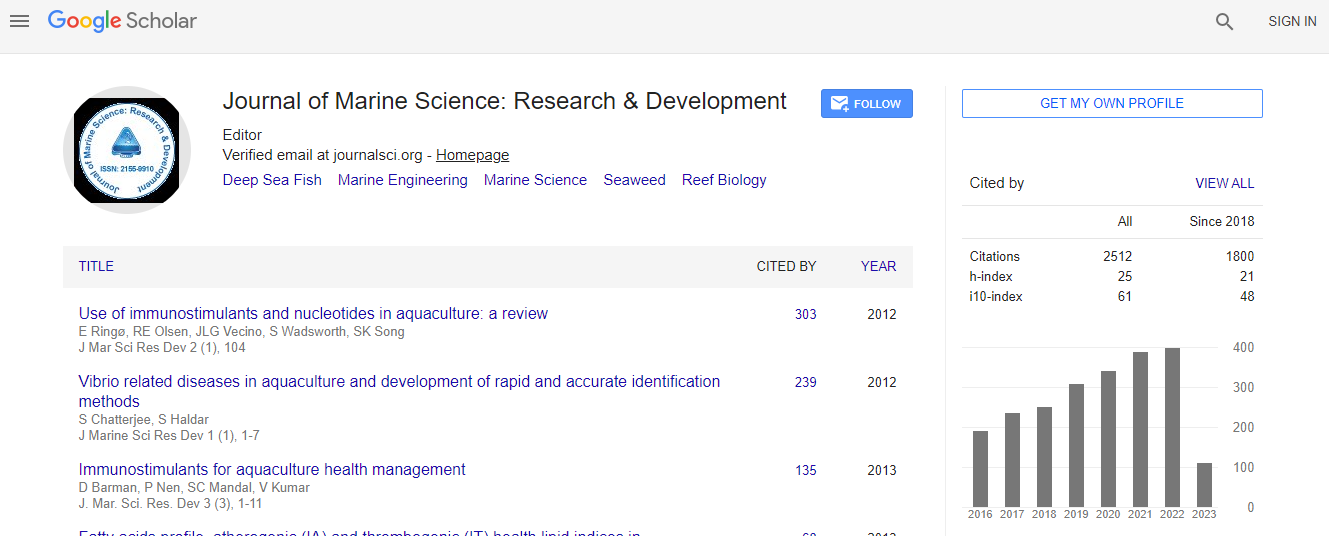Research Article
Impact of Different Colors of Artificial Light on Pigmentation and Growth Performance of Hybrid Red Tilapia (Oreochromis mosambicus × O. hornorum) Reared in Saline Well Water
Hadir A Aly, Mohamed M Abdel-Rahim*, Basem S Abdelaty, and Ayman M LotfyFish Rearing Lab, Aquaculture division, National Institute of Oceanography and Fisheries (NIOF), Alexandria, Egypt
- *Corresponding Author:
- Mohamed M Abdel-Rahim
Fish Rearing Lab, Aquaculture Division
National Institute of Oceanography and Fisheries (NIOF)
Alexandria, Egypt
Tel: +20 100 692 9599
E-mail: mohamed_m_ar@yahoo.com
Received date: May 01, 2017; Accepted date: May 22, 2017; Published date: May 29, 2017
Citation: Aly HA, Abdel-Rahim MM, Abdelaty BS, Lotfy AM (2017) Impact of Different Colors of Artificial Light on Pigmentation and Growth Performance of Hybrid Red Tilapia (Oreochromis mosambicus × O. hornorum) Reared in Saline Well Water. J Marine Sci Res Dev 7:229. doi: 10.4172/2155-9910.1000229
Copyright: © 2017 Aly HA, et al. This is an open-access article distributed under the terms of the Creative Commons Attribution License, which permits unrestricted use, distribution, and reproduction in any medium, provided the original author and source are credited.
Abstract
Four light colors (red, white, green and blue) were tested to evaluate their effects on both body color enhancement and growth performance of Florida red tilapia (Oreochromis mosambicus ÃÃâ O. hornorum). Fish were stocked in 12 fiberglass tanks, (each of 2 m3 water volume), at a stocking rate of 100 fish per tank with average (p âÃâ°¤ 0.05) are observed in the whole body chemical composition between treatments. Fingerlings initial weight of 2.66 g/fish, three replicates for each treatment. Fish were fed on a commercial diet containing 25% protein, two meals per day with a daily feeding rate of 7% in the first two weeks, then reduced to 5% until the end of the experimental period (6 weeks). The results of this study reveals that there are no significant differences (p>0.05) in growth performance indexes between treatments. However, fish exposed to red color showed highest growth values. With the same trend, results of survival percent and condition factor showed no significant differences between treatments. Significant differences that are exposed to blue color has the highest value of dry matter content, while, the lowest value is observed in fingerlings exposed to red color. Feed utilization (FI, FCR and PER) do not significantly affect the lighting color, while protein and energy utilization (PPV and EU) are significantly affected. Concerning the red color accumulated in the fish body, the fingerlings which are exposed to the blue color achieved the best β-carotene value (211.25 IU/100 g fish) with highly significant differences compared with other treatments. The content of β-carotene in blue color treatment is 8, 9, and 16 folds comparing with green, white, and red colors, respectively. Also, Red tilapia fish with black spots in the blue treatment were 12%, compared with 29% in green, 56% in white and 52% in red colors. It could be concluded that cultivating Red tilapia in a full saline well water using the artificial blue color will significantly improve not only the pigmentation of Red tilapia, the quality of fish in terms of the content of dry matter, but also the protein and the energy utilization of the consumed feed.

 Spanish
Spanish  Chinese
Chinese  Russian
Russian  German
German  French
French  Japanese
Japanese  Portuguese
Portuguese  Hindi
Hindi 